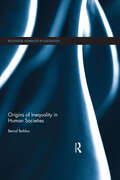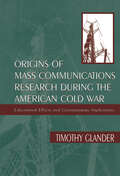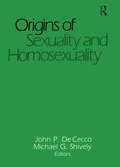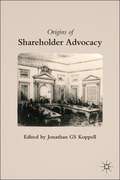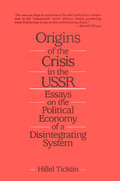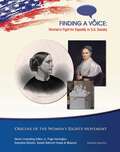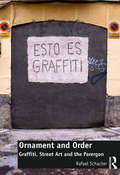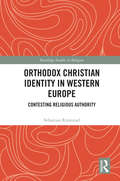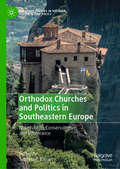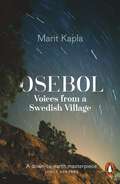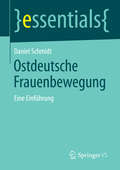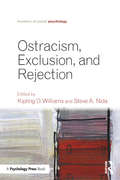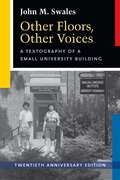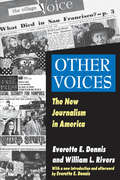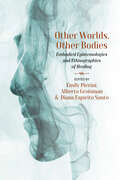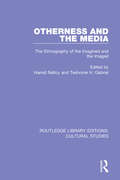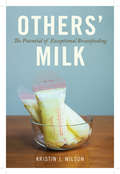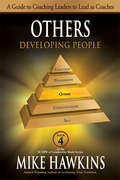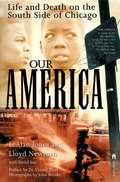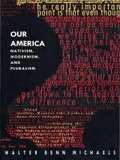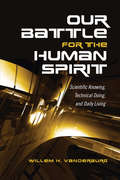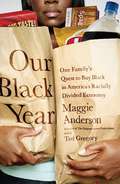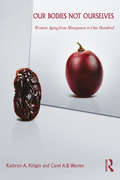- Table View
- List View
Origins and Destinations: The Making of the Second Generation
by Roger Waldinger Renee Luthra Thomas SoehlThe children of immigrants continue a journey begun by their parents. Born or raised in the United States, this second generation now stands over 20 million strong. In this insightful new book, immigration scholars Renee Luthra, Thomas Soehl, and Roger Waldinger provide a fresh understanding the making of the second generation, bringing both their origins and destinations into view. Using surveys of second generation immigrant adults in New York and Los Angeles, Origins and Destinations explains why second generation experiences differ across national origin groups and why immigrant offspring with the same national background often follow different trajectories. Inter-group disparities stem from contexts of both emigration and immigration. Origin countries differ in value orientations: immigrant parents transmit lessons learned in varying contexts of emigration to children raised in the U.S. A system of migration control sifts immigrants by legal status, generating a context of immigration that favors some groups over others. Both contexts matter: schooling is higher among immigrant children from more secular societies (South Korea) than among those from more religious countries (the Philippines). When immigrant groups enter the U.S. migration system through a welcoming door, as opposed to one that makes authorized status difficult to achieve, education propels immigrant children to better jobs. Diversity is also evident among immigrant offspring whose parents stem from the same place. Immigrant children grow up with homeland connections, which can both hurt and harm: immigrant offspring get less schooling when a parent lives abroad, but more schooling if parents in the U.S. send money to relatives living abroad. Though all immigrants enter the U.S. as non-citizens, some instantly enjoy legal status, while others spend years in the shadows. Children born abroad, but raised in the U.S. are all everyday Americans, but only some have become de jure Americans, a difference yielding across-the-board positive effects, even among those who started out in the same country. Disentangling the sources of diversity among today’s population of immigrant offspring, Origins and Destinations provides a compelling new framework for understanding the second generation that is transforming America.
Origins of Inequality in Human Societies (Routledge Advances in Sociology)
by Bernd BaldusSince the beginning of social life human societies have faced the problem how to distribute the results of collaborative activities among the participants. The solutions they found ranged from egalitarian to unequal but caused more dissension and conflict than just about any other social structure in human history. Social inequality also dominated the agenda of the new field of sociology in the 19th century. The theories developed during that time still inform academic and public debates, and inequality continues to be the subject of much current controversy. Origins of Inequality begins with a critical assessment of classical explanations of inequality in the social sciences and the political and economic environment in which they arose. The book then offers a new theory of the evolution of distributive structures in human societies. It examines the interaction of chance, intent and unforeseen consequences in the emergence of social inequality, traces its irregular historical path in different societies, and analyses processes of social control which consolidated inequality even when it was costly or harmful for most participants. Because the evolution of distributive structures is an open process, the book also explores issues of distributive justice and options for greater equality in modern societies. Along with its focus on social inequality the book covers topics in cultural evolution, social and economic history and social theory. This book will appeal to scholars and advanced students of sociology, economics and anthropology – in particular sociological theory and social inequality.
Origins of Mass Communications Research During the American Cold War: Educational Effects and Contemporary Implications (Sociocultural, Political, and Historical Studies in Education)
by Timothy GlanderIn this critical examination of the beginnings of mass communications research in the United States, written from the perspective of an educational historian, Timothy Glander uses archival materials that have not been widely studied to document, contextualize, and interpret the dominant expressions of this field during the time in which it became rooted in American academic life, and tries to give articulation to the larger historical forces that gave the field its fundamental purposes. By mid-century, mass communications researchers had become recognized as experts in describing the effects of the mass media on learning and other social behavior. However, the conditions that promoted and sustained their authority as experts have not been adequately explored. This study analyzes the ideological and historical forces giving rise to, and shaping, their research. Until this study, the history of communications research has been written almost entirely from within the field of communications studies and, as a result, has tended to refrain from asking troubling foundational questions about the origins of the field or to entertain how its emergence shaped educational discourse during the post-World War II period. By examining the intersection between the individual biographies of key leaders in the communications field (Wilbur Schramm, Paul Lazarsfeld, Bernard Berelson, Hadley Cantril, Stuart Dodd, and others) and the larger historical context in which they lived and worked, this book aims to tell part of the story of how the field of communications became divorced from the field of education. The book also examines the work of significant voices on the rise of mass communications study (including C. Wright Mills, William W. Biddle, Paul Goodman, and others) who theorized about the emergence of a mass society. It concludes with a discussion of the contemporary relevance of the theory of a mass society to educational thought and practice.
Origins of Sexuality and Homosexuality
by John Dececco, Phd Michael ShivelyThis well-documented book highlights some of the theories of bisexual and homosexual identities and their conceptual bases in cultural history, moral philosophy, biology, and social psychology. Some of the most respected minds in the field of human sexuality challenge traditional views on homosexuality and question the moral principles implicit in many existing psychiatric and psychological theories.
Origins of Shareholder Advocacy
by Jonathan Gs KoppellThis volume deals with issues of widespread interest including, the origins of investor rights in different markets, the political, legal and economic conditions that determine levels of shareholder participation, and the implications of variation in investor rights.
Origins of the Crisis in the U.S.S.R.: Essays on the Political Economy of a Disintegrating System
by Hillel TicktinHillel Ticktin has been one of the most controversial figures in Soviet studies for 25 years. His assertions that the Soviet economy was hopelessly inefficient, that the ruble was a sham, and that the elite was desperate once sounded outrageous. Ticktin consistently argued that perestroika would fail. In his view the USSR was and remained inherently Stalinist. It might lurch back and forth between reformist and reactionary leadership factions but, the system could not evolve, nor could it be restructured. Ultimately, it could only disintegrate, and when it did, the workers would hold the balance. This collection of essays offers a thorough sample of his views.
Origins of the Women's Rights Movement (Finding a Voice: Women's Fight for Equal)
by Leeanne GelletlyIn the 1800s, women were second-class citizens. By law, married women were owned by their husbands. Women had no political rights. They could not vote. They could not hold office. By custom, women did not dare speak before men in public. But some women refused to be silenced. They saw wrongs in the world that needed fixing. The injustice of slavery led women like Lucretia Mott, Angelina Grimké, and Lucy Stone to step outside traditional roles. As women abolitionists, they lectured, circulated petitions, and lobbied lawmakers. But female reformers soon became frustrated. Men-only groups prevented women from speaking. Their help was often rejected. This led a determined few to call for equal rights for women. Among the movement's early leaders were Elizabeth Cady Stanton and Susan B. Anthony. Along with many other women activists, they would fight for a woman's right to be a true citizen of the United States.
Ornament and Order: Graffiti, Street Art and the Parergon
by Rafael SchacterOver the last forty years, graffiti and street-art have become a global phenomenon within the visual arts. Whilst they have increasingly been taken seriously by the art establishment (or perhaps the art market), their academic and popular examination still remains within old debates which argue over whether these acts are vandalism or art, and which examine the role of graffiti in gang culture and in terms of visual pollution. Based on an in-depth ethnographic study working with some of the world’s most influential Independent Public Artists, this book takes a completely new approach. Placing these illicit aesthetic practices within a broader historical, political, and aesthetic context, it argues that they are in fact both intrinsically ornamental (working within a classic architectonic framework), as well as innately ordered (within a highly ritualized, performative structure). Rather than disharmonic, destructive forms, rather than ones solely working within the dynamics of the market, these insurgent images are seen to reface rather than deface the city, operating within a modality of contemporary civic ritual. The book is divided into two main sections, Ornament and Order. Ornament focuses upon the physical artifacts themselves, the various meanings these public artists ascribe to their images as well as the tensions and communicative schemata emerging out of their material form. Using two very different understandings of political action, it places these illicit icons within the wider theoretical debate over the public sphere that they materially re-present. Order is focused more closely on the ephemeral trace of these spatial acts, the explicitly performative, practice-based elements of their aesthetic production. Exploring thematics such as carnival and play, risk and creativity, it tracks how the very residue of this cultural production structures and shapes the socio-ethico guidelines of these artists’ lifeworlds.
Orthodox Christian Identity in Western Europe: Contesting Religious Authority (Routledge Studies in Religion)
by Sebastian RimestadThis book analyses the discourses of Orthodox Christianity in Western Europe to demonstrate the emerging discrepancies between the mother Church in the East and its newer Western congregations. Showing the genesis and development of these discourses over the 20th century, it examines the challenges the Orthodox Church is facing in the modern world. Organised along four different discursive fields, the book uses these fields to bring valuable insights the contemporary Orthodox Church. It explores pastoral, ecclesiological, institutional and ecumenical discourses in order to present a holistic view of how the Church views itself and how it seeks to interact with other denominations. Taken together, these four discursive fields reveal a discursive vitality outside of the traditionally Orthodox societies that is, however, only partly reabsorbed by the church hierarchs in core Orthodox regions, like Southeast Europe and Russia. The Orthodox Church is a complex and multifaceted global reality.Therefore, this book will be a vital guide to scholars studying the Orthodox Church, ecumenism and religion in Europe, as well as those working in religious studies, sociology of religion, and theology more generally.
Orthodox Churches and Politics in Southeastern Europe: Nationalism, Conservativism, and Intolerance (Palgrave Studies in Religion, Politics, and Policy)
by Sabrina P. RametOrthodox Churches, like most religious bodies, are inherently political: they seek to defend their core values and must engage in politics to do so, whether by promoting certain legislation or seeking to block other legislation. This volume examines the politics of Orthodox Churches in Southeastern Europe, emphasizing three key modes of resistance to the influence of (Western) liberal values: Nationalism (presenting themselves as protectors of the national being), Conservatism (defending traditional values such as the “traditional family”), and Intolerance (of both non-Orthodox faiths and sexual minorities). The chapters in this volume present case studies of all the Orthodox Churches of the region.
Osebol: Voices from a Swedish Village
by Marit KaplaA SUNDAY TELEGRAPH AND GUARDIAN BOOK OF THE YEARWINNER OF SWEDEN'S AUGUST PRIZEWINNER OF THE WARWICK PRIZE FOR WOMEN IN TRANSLATIONSHORTLISTED FOR THE BRITISH ACADEMY BOOK PRIZE'Osebol is a magnificent success; it is hard to imagine it better ... Kapla is a magician ... mesmerizing' Sara Wheeler, TLS'A simple, pared-back and down-to-earth masterpiece' James Rebanks'We listen to them like something caught on the wind ... so moving and so strangely beckoning' Nicci Gerrard, Observer'[Among] the year's most pleasing books' Rishi Dastidar, Guardian, Books of the Year'Engrossing and humbling and quietly revelatory' Max Porter'Fascinating ... I was riveted' Lydia Davis'Like standing outside an open window on a warm summer evening and listening to a piece of contemporary history' Länstidningen'What a wonderful book . . . You want to move into it' ExpressenNear the river Klarälven, snug in the dense forest landscape of northern Värmland, lies the secluded village of Osebol. It is a quiet place: one where relationships take root over decades, and where the bustle of city life is replaced by the sound of wind in the trees.In this extraordinary and engrossing book, an unexpected cultural phenomenon in its native Sweden, the stories of Osebol's residents are brought to life in their own words. Over the last half-century, the automation of the lumber industry and the steady relocations to the cities have seen the village's adult population fall to roughly forty. But still, life goes on; heirlooms are passed from hand to hand, and memories from mouth to mouth, while new arrivals come from near and far.Marit Kapla has interviewed nearly every villager between the ages of 18 and 92, recording their stories verbatim. What emerges is at once a familiar chronicle of great social metamorphosis, told from the inside, and a beautifully microcosmic portrait of a place and its people. To read Osebol is to lose oneself in its gentle rhythms of simple language and open space, and to emerge feeling like one has really grown to know the inhabitants of this varied community, nestled among the trees in a changing world.
Ostdeutsche Frauenbewegung: Eine Einführung (essentials)
by Daniel SchmidtIn Beiträgen, die sich mit dem Bevölkerungsrückgang in der Bundesrepublikbeschäftigen, liegt der Fokus regelmäßig auf Frauen und ihrer ,,Fertilität",also der Potenz oder auch Entscheidung, Kinder (nicht) zu bekommen. ImZusammenhang mit den sogenannten Neuen Bundesländern findet man indemografischen Debatten des ersten Jahrzehnts des 21. Jahrhunderts häufig noch ein anderes Narrativ: Vor allem junge, gut ausgebildete Frauen kehrten in großem Maßstab ihrer ,,Heimat" den Rücken, um ,,im Westen" ihr Glück zu suchen. Daniel Schmidt verortet diese Erzählung in ihren historischen, wissens- sowie bevölkerungspolitischen Kontexten und rekonstruiert die dahinterliegenden kategorialen Subjektivierungen. Schließlich skizziert er politische Konsequenzen dieses spezifischen Bevölkerungswissens.
Ostracism, Exclusion, and Rejection: Ostracism, Social Exclusion, Rejection, And Bullying (Frontiers of Social Psychology #Vol. 7)
by Kipling D. Williams Steve A. NidaOstracism, Exclusion, and Rejection examines research into the related phenomena of ostracism, exclusion and rejection. Most individuals have experienced both sides of the coin: being ostracized and ostracizing others. People experience mild forms of ostracism on a daily basis, but some endure years and decades of being the social outcast. How does it feel to be shunned, left out, not wanted? Research suggests that even the mildest and briefest forms of ostracism are painful and have downstream consequences to our feelings of social connection. Longer-term ostracism has devastating consequences on individuals’ health and well-being. This innovative compilation covers how being cast out affects the brain and body chemistry, feelings and emotions, thoughts and beliefs, and behaviors. In addition to the primary focus on targets of ostracism, researchers also examine the motives and consequences of ostracizing. Social scientists from social psychology, developmental psychology, neuroscience, communication science, cross-cultural psychology, and anthropology tackle these questions with cutting-edge methods and provocative theories. A key volume for all in those fields, this book also presents applications from the schoolyard to the workplace, and sounds a much-needed call for further research on this universal behavior of all social animals.
Other Cities, Other Worlds: Urban Imaginaries in a Globalizing Age
by Andreas HuyssenOther Cities, Other Worlds brings together leading scholars of cultural theory, urban studies, art, anthropology, literature, film, architecture, and history to look at non-Western global cities. The contributors focus on urban imaginaries, the ways that city dwellers perceive or imagine their own cities. Paying particular attention to the historical and cultural dimensions of urban life, they bring to their essays deep knowledge of the cities they are bound to in their lives and their work. Taken together, these essays allow us to compare metropolises from the so-called periphery and gauge processes of cultural globalization, illuminating the complexities at stake as we try to imagine other cities and other worlds under the spell of globalization. The effects of global processes such as the growth of transnational corporations and investment, the weakening of state sovereignty, increasing poverty, and the privatization of previously public services are described and analyzed in essays by Teresa P. R. Caldeira (So Paulo), Beatriz Sarlo (Buenos Aires), Nstor Garca Canclini (Mexico City), Farha Ghannam (Cairo), Gyan Prakash (Mumbai), and Yingjin Zhang (Beijing). Considering Johannesburg, the architect Hilton Judin takes on themes addressed by other contributors as well: the relation between the country and the city, and between racial imaginaries and the fear of urban violence. Rahul Mehrotra writes of the transitory, improvisational nature of the Indian bazaar city, while AbdouMaliq Simone sees a new urbanism of fragmentation and risk emerging in Douala, Cameroon. In a broader comparative frame, Okwui Enwezor reflects on the proliferation of biennales of contemporary art in African, Asian, and Latin American cities, and Ackbar Abbas considers the rise of fake commodity production in China. The volume closes with the novelist Orhan Pamuk's meditation on his native city of Istanbul. Contributors: Ackbar Abbas, Teresa P. R. Caldeira, Nstor Garca Canclini, Okwui Enwezor, Farha Ghannam, Andreas Huyssen, Hilton Judin, Rahul Mehrotra, Orhan Pamuk, Gyan Prakash, Beatriz Sarlo, AbdouMaliq Simone, Yingjin Zhang
Other Floors, Other Voices, Twentieth Anniversary Edition: A Textography of a Small University Building
by John M. Swales“John Swales’ textography might also be called ‘comparative rhetoric in a small building,’ offering proof, once again, that another culture may be only a trip up or down a flight of stairs. . . .such an appealing and original book.” ---BAAL News Originally published in 1998, Other Floors, Other Voices uses texts to capture the lives of three communities operating within a single building (the North University Building, or NUBS) on the University of Michigan campus. Swales' thoughtful exploration of the three units—the Computer Resource Site, the University Herbarium (botany), and the English Language Institute—centers around the individuals who work on each floor and the discourse-related activities they engage in. The Twentieth Anniversary Edition of Other Floors, Other Voices includes: a new preface, an introductory essay on the value of rereading this volume many years after publication, and an epilogue that reflects on and reveals what has happened to the three units in the past 20 years.
Other Voices: The New Journalism in America
by Everette DennisConflicting journalistic voices that were raised in the past have become such a jumble that merely identifying them is difficult. Dennis and Rivers define, categorize, present, and examine the voices that contributed to what became known as "the new media" environment in the 1970s. This new journalism came about as a result of dissatisfaction with existing values and standards of the early 1960s style of journalism.The authors are comprehensive in their concerns, as reflected in the national scope presented. They cover developments in the major cities, on both coasts, in the Middle West and South in every major region of the United States. Most of the research required travel and interviews; all of it required reading almost endlessly and watching the video productions of journalists who built the structure of alternative television. Dennis and Rivers offer a representative view of forms and media, as well as the people who fashioned the new orientation.The authors claim that the wrangling over objective and interpretative reporting misses the main point, which is that neither is in close touch with reality. The best objective report may cover all surfaces of an event, the best interpretative report may explain all its meanings, but both are bloodless, a world away from the experience. Color, flavor, atmosphere, the ultimate human meaning all these, the new journalists contend, are far beyond the reach of traditional models of journalism. This is one of the central reasons for the emergence of different forms and practices in our time. This volume will help younger scholars understand the sources of quasi-journalistic practices extant today, including blogging and electronic-only publications.
Other Worlds, Other Bodies: Embodied Epistemologies and Ethnographies of Healing
by Emily Pierini, Alberto Groisman, and Diana Espírito SantoWhen approaching the multiplicity of the spiritual experiences of healing, ethnographers are often presented with ideas of the existence of “other” worlds that may intersect with the so-called “material” or “physical” worlds. This book proposes a sensory ethnography of healing with a focus on ethnographic knowing as embedded in an embodied epistemology of healing. Epistemological embodiment signals that personal scholarly experience of the “unknown”—be it in the form of trance, or as the embodiment of an “other”—shapes the concepts of healing, body, trance, self, and matter by which ethnographers craft out analysis.
Otherness and the Media: The Ethnography of the Imagined and the Imaged (Routledge Library Editions: Cultural Studies)
by Hamid Naficy Teshome H. GabrielThis anthology on otherness and the media, first published in 1993, was prompted by the proliferation of writings centring on issues of ‘difference’, ‘diversity’, ‘multiculturalism’, ‘representation’ and ‘postcolonial’ discourses. Such issues and discourses question existing canons of criticism, theory and cultural practice but also because they suggest a new sense of direction in theorisation of difference and representation.
Others' Milk: The Potential of Exceptional Breastfeeding
by Kristin J. WilsonBreastfeeding rarely conforms to the idealized Madonna-and-baby image seen in old artwork, now re-cast in celebrity breastfeeding photo spreads and pro-breastfeeding ad campaigns. The personal accounts in Others’ Milk illustrate just how messy and challenging and unpredictable it can be—an uncomfortable reality in the contemporary context of high-stakes motherhood in which “successful” breastfeeding proves one’s maternal mettle. Exceptional breastfeeders find creative ways to feed and care for their children—such as by inducing lactation, sharing milk, or exclusively pumping. They want to adhere to the societal ideal of giving them “the best” but sometimes have to face off with dogmatic authorities in order to do so. Kristin J. Wilson argues that while breastfeeding is never going to be the feasible choice for everyone, it should be accessible to anyone.
Others: Developing People (SCOPE of Leadership Book Series #4)
by Mike HawkinsFocus on supporting and coaching employees with the third book in the “most comprehensive treatment of leadership I’ve ever seen by one author” (Jim Kouzes, coauthor of The Leadership Challenge).Others: Developing People guides you in building the skills of others and developing top performers. Great leaders build teams of competent people who are able and willing to take ownership for the work that needs to be performed. By learning the competencies of coaching, enabling, and holding people accountable, you multiply your abilities, transfer your knowledge, and leave an enduring legacy.The SCOPE of Leadership book series teaches the principles of a coaching approach to leadership and how to achieve exceptional results by working through people. You will learn a straightforward framework to guide you in developing, enabling, exhorting, inspiring, managing, and assimilating people. Benefit from the wisdom of many years of leadership, consulting, and executive coaching experience. Discover how to develop the competencies that align consistently with great leadership.
Our America: Life and Death on the South Side of Chicago
by Lealan Jones Lloyd Newman David IsayThrough two award-winning National Public Radio documentaries, and now this powerful book, LeAlan Jones and Lloyd Newman have made it their mission to be loud voices from one of this country's darkest places, Chicago's Ida B. Wells housing project. Set against the stunning photographs of a talented young photographer from the projects,Our America evokes the unforgiving world of these two amazing young men, and their struggle to survive unrelenting tragedy. With a gift for clear-eyed journalism, they tell their own stories and others, including that of the death of Eric Morse, a five-year-old who was dropped to his death from the fourteenth floor of an Ida B. Wells apartment building by two other little boys. Sometimes funny, often painful, but always charged with their dream of Our America,LeAlan Jones and Lloyd Newman reach out to grab your attention and break your heart.
Our America: Nativism, Modernism, and Pluralism
by Walter Benn MichaelsArguing that the contemporary commitment to the importance of cultural identity has renovated rather than replaced an earlier commitment to racial identity, Walter Benn Michaels asserts that the idea of culture, far from constituting a challenge to racism, is actually a form of racism. Our America offers both a provocative reinterpretation of the role of identity in modernism and a sustained critique of the role of identity in postmodernism."We have a great desire to be supremely American," Calvin Coolidge wrote in 1924. That desire, Michaels tells us, is at the very heart of American modernism, giving form and substance to a cultural movement that would in turn redefine America's cultural and collective identity--ultimately along racial lines. A provocative reinterpretation of American modernism, Our America also offers a new way of understanding current debates over the meaning of race, identity, multiculturalism, and pluralism.Michaels contends that the aesthetic movement of modernism and the social movement of nativism came together in the 1920s in their commitment to resolve the meaning of identity--linguistic, national, cultural, and racial. Just as the Johnson Immigration Act of 1924, which excluded aliens, and the Indian Citizenship Act of the same year, which honored the truly native, reconceptualized national identity, so the major texts of American writers such as Cather, Faulkner, Hurston, and Williams reinvented identity as an object of pathos--something that can be lost or found, defended or betrayed. Our America is both a history and a critique of this invention, tracing its development from the white supremacism of the Progressive period through the cultural pluralism of the Twenties. Michaels's sustained rereading of the texts of the period--the canonical, the popular, and the less familiar--exposes recurring concerns such as the reconception of the image of the Indian as a symbol of racial purity and national origins, the relation between World War I and race, contradictory appeals to the family as a model for the nation, and anxieties about reproduction that subliminally tie whiteness and national identity to incest, sterility, and impotence.
Our Battle for the Human Spirit: Scientific Knowing, Technical Doing, and Daily Living
by Willem H. VanderburgWestern society has become saturated with scientific and technological modes of thinking that impact our lives and our relationships. Expanding social inequality, the use of social media and the rise of mental illnesses such as anxiety and depression are manifestations of this shift in our civilization.Our Battle for the Human Spirit is a comprehensive probe into what is happening to human life in the beginning of the 21st century. It explores how culture, experience, and symbolization have been replaced by scientific, discipline-based, approaches. Willem H. Vanderburg argues that these approaches are inadequate in understanding the complexity of human lives and societies. In order to transcend these limits, Vanderburg calls for the reintegration of culture and symbolization into our daily lives.
Our Black Year: One Family's Quest to Buy Black in America's Racially Divided Economy
by Maggie AndersonMaggie and John Anderson were successful African American professionals raising two daughters in a tony suburb of Chicago. But they felt uneasy over their good fortune. Most African Americans live in economically starved neighborhoods. Black wealth is about one tenth of white wealth, and black businesses lag behind businesses of all other racial groups in every measure of success. One problem is that black consumers--unlike consumers of other ethnicities-- choose not to support black-owned businesses. At the same time, most of the businesses in their communities are owned by outsiders. On January 1, 2009 the Andersons embarked on a year-long public pledge to "buy black. " They thought that by taking a stand, the black community would be mobilized to exert its economic might. They thought that by exposing the issues, Americans of all races would see that economically empowering black neighborhoods benefits society as a whole. Instead, blacks refused to support their own, and others condemned their experiment. Drawing on economic research and social history as well as her personal story, Maggie Anderson shows why the black economy continues to suffer and issues a call to action to all of us to do our part to reverse this trend.
Our Bodies Not Ourselves: WOMEN AGING FROM MENOPAUSE TO ONE HUNDRED
by Kathryn A. Kirigin Carol A.B. WarrenIn 1970, the best-seller Our Bodies Ourselves was published. The focus of the authors, the Boston Health Collective, was on the youthful female body: on reproduction, sexuality, genitalia, intimacy and relationships in the context of North American cultural expectations. Our Bodies Not Ourselves is also about the female body—but on women aging from menopause to 100. Like its predecessor, Our Bodies Not Ourselves covers sexuality, genitalia, intimacy, gender norms and relationships. But the aging woman's body has many other issues, from head to toe, from skeleton to skin, and from sleep to motion. The book, an ethnography and Western cultural history of aging and gender, draws upon history, culture and social media, the authors’ own experiences as women of 70, and conversations and correspondence with more than two hundred women aged from 60-ish to 100. They consider the cultural and structural frameworks for contemporary aging: the long sweep of history, gendered cultural norms and the vast commercial and medical marketplaces for maintaining and altering the aging body. Part I, The Private Body, focuses on the embodied experiences of aging within our private households. Part II, The Public Body, explores weight, height, and adornment as old women appear among others. Part III, The Body With Others, sets the embodied experiences of aging women within their sexual and social relationships.

